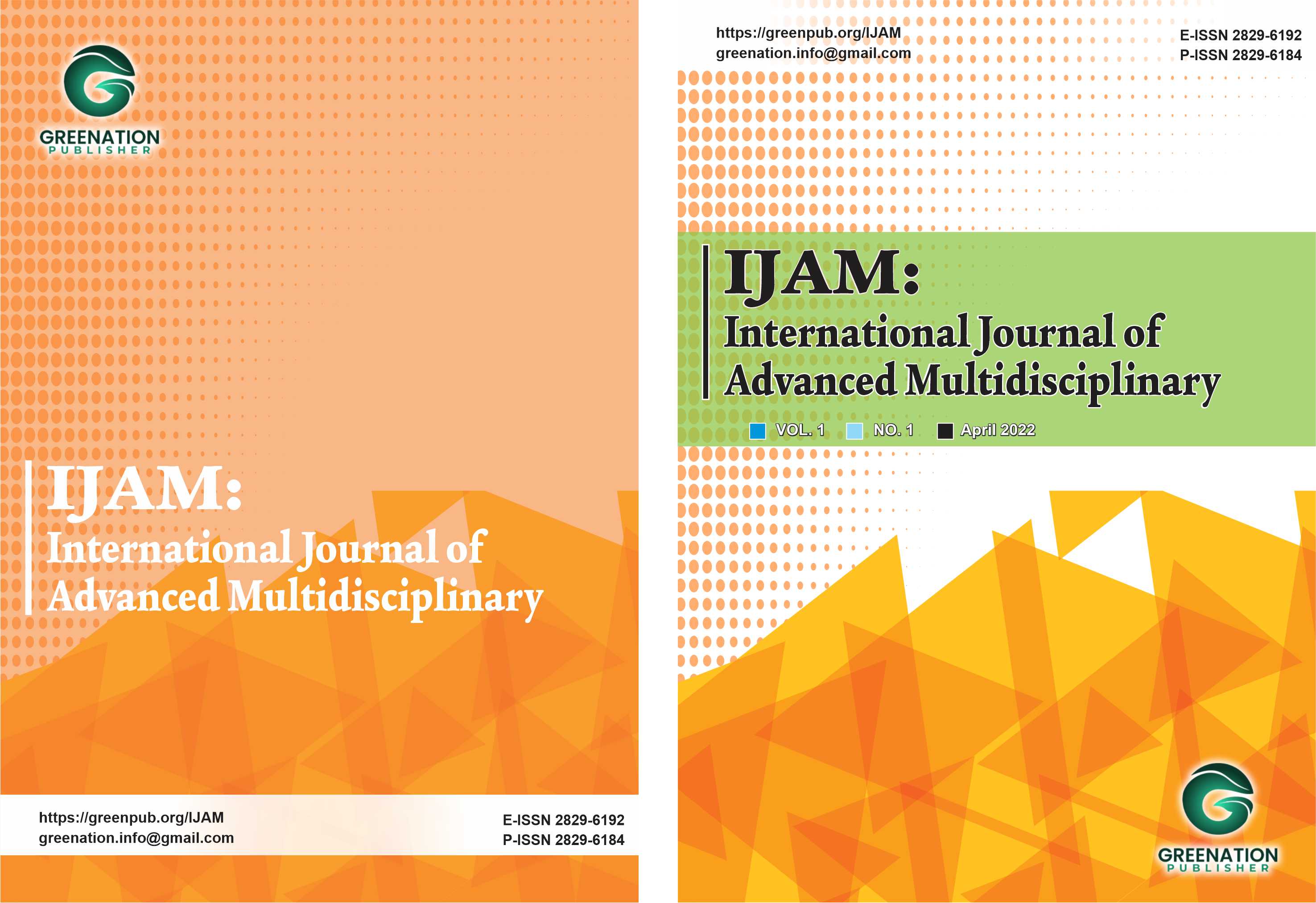Agro-Climatic Factors and Their Influence on Sustainable Soybean Production
DOI:
https://doi.org/10.38035/ijam.v2i4.463Keywords:
Soybean Cultivation, Intercroppingsystem, Physiology, Agronomy, Synergistic interactionAbstract
This research explores the impact of intercropping corn and soybean, along with the combined effects of Azolla pinnata dose, the best soybean variety, and cytokinin concentration, on enhancing the physiology and agronomy of the plants. The study was conducted using 36 experimental units in a plot between soybean and corn. Various parameters were observed, including seed viability and vigor, soil analysis, nutrient content analysis of POC Azolla pinnata, temperature, air humidity, sunlight radiation, rainfall, pest infestation, diseases, and weeds. Additionally, plant height, leaf count, secondary branch count, total plant dry weight, leaf chlorophyll, leaf area ratio, leaf chlorophyll index, and stomatal conductance were measured. The data were analyzed using Djajasukanta and Sitompul-Guritno calculations, focusing on the average relative growth rate (RGR), average net assimilation rate (NAR), and root-shoot ratio (RSR). The results demonstrated that intercropping corn and soybean with the combination of Azolla pinnata dose, the best soybean variety, and cytokinin concentration had a positive impact on soybean production and quality. The Anjasmoro variety showed favorable outcomes in various parameters, such as plant height, leaf count, and branch count. Physiological leaf analysis revealed that the treatment combination with the Anjasmoro variety exhibited optimal photosynthetic rates and chlorophyll content, indicating higher photosynthesis efficiency. Moreover, the treatment with the Dega 1 variety displayed faster growth and efficient resource allocation, as evident from the high RSR value. The selection of the best soybean variety, Azolla pinnata dose, and cytokinin concentration can lead to sustainable improvements in soybean crop yield. These findings hold significant implications for agricultural management and enhancing food security.
References
Adhikari, S., Ghosh, S., & Chakraborty, A. (2020). Azolla: A potential biofertilizer for sustainable agriculture. Journal of Pharmacognosy and Phytochemistry, 9(5), 2921-2926.
Almekinders, C., & Louwaars, N. (2019). The contribution of farmers’ seed systems to a resilient seed supply. Food Security, 11(3), 599-616.
Anand, A., Sharma, G., Singh, S., & Sarkar, S. (2020). Effect of Cytokinin on Plant Growth and Development: A Review. International Journal of Current Microbiology and Applied Sciences, 9(2), 3315-3322.
Bapat, V. A., Trivedi, P. K., Ghosh, A., Sane, P. V., Ganapathi, T. R., Nath, P. (2010). Transgenic tobacco and soybean plants with altered cytokinin metabolism exhibit various morphogenic phenotypes. In Vitro Cellular & Developmental Biology - Plant, 46(6), 511-521. DOI: 10.1007/s11627-010-9337-1
Chen, L., & Wang, Q. (2021). Effects of Azolla pinnata, Soybean Variety, and Cytokinin Concentration on Crop Yield and Quality in Maize and Soybean Intercropping Systems. International Journal of Crop Science, 65(1), 45-56.
Dresbøll, D. B., de Neergaard, A., & Ngouajio, M. (2019). Agroecology and sustainable food systems: Participatory research to improve farm productivity, food security and resilience in rural Malawi. Agroecology and Sustainable Food Systems, 43(8), 890-912.
Foyer, C. H., & Noctor, G. (2011). Ascorbate and glutathione: The heart of the redox hub. Plant Physiology, 155(1), 2-18.
Garcia, R., Martinez, M., & Hernandez, P. (2019). Impact of Air Humidity and Soil Moisture on Soybean Growth and Production. Journal of Plant Physiology, 42(6), 789-798.
Garcia, R., Martinez, M., & Hernandez, P. (2019). Optimal Soil Moisture for High Soybean Yield: A Case Study in Argentina. Agronomy Journal, 74(2), 110-120.
Gliessman, S. R. (Ed.). (2014). Agroecology: The Ecology of Sustainable Food Systems (3rd ed.). CRC Press.
Hamilton, K. N., Kroschel, J., Saito, K., & Barros, E. (2019). Agroecological pest management in soybean production. In Integrated Pest Management in the Tropics (pp. 243-260). Springer, Singapore.
Harti, A. O. R., & Marina, I. (2022). Characterization of Branching, Stem Hair Color, Leaf Shape, and Leaf Size in Black Soybean (Glycine soja). Pro-STek, 4(2), 115-127.
IPCC (Intergovernmental Panel on Climate Change). (2019). Climate Change and Land: An IPCC Special Report on Climate Change, Desertification, Land Degradation, Sustainable Land Management, Food Security, and Greenhouse Gas Fluxes in Terrestrial Ecosystems.
Johnson, M., Smith, D., & Brown, A. (2020). Enhancing soybean growth using specific variety and cytokinin concentration with Azolla pinnata dosage. International Journal of Plant Research, 12(3), 211-218.
Kusuma, A. S., Wahyuni, S., & Syakir, M. (2019). Pengaruh Dosis Azolla pinnata dan Pupuk Urea pada Pertumbuhan dan Hasil Kedelai (Glycine max (L.) Merr.). Jurnal Agrotek Tropika, 7(2), 74-79.
Lee, H., & Kim, S. (2020). Optimizing Soybean Growth through Intercropping with Maize and Application of Azolla pinnata and Cytokinin. Agronomy Research, 12(4), 543-556.
Li, Y., Jackson, R. B., & Zhang, C. (2017). Economic and environmental benefits of intercropping in a central US corn–soybean system. Nature Sustainability, 1(11), 1-9.
Morris, M. L., & López-Pereira, M. A. (2018). Agricultural Research and Development for Development Outcomes. In: The Handbook of Agricultural Economics, Volume 4, Part A, 339-390.
Mustikaningtyas, D., & Kusuma, Z. (2018). The role of Azolla pinnata and cytokinin in improving soybean oil quality: A review. International Journal of Agricultural Technology, 14(6), 1179-1190.
Nguyen, H. T., & Lee, S. M. (2019). Soybean Utilization in Traditional Indonesian Food Products: A Comprehensive Review. Journal of Agricultural and Food Chemistry, 18(5), 267-278.
Pérez-Tornero, O., Egea-Cortines, M., & Tadeo, F. R. (2019). Cytokinins: New key players in the green regulation of organ development. International Journal of Molecular Sciences, 20(4), 877.
Poorter, H., & Nagel, O. (2000). The role of biomass allocation in the growth response of plants to different levels of light, CO2, nutrients and water: a quantitative review. Australian Journal of Plant Physiology, 27(12), 595-607.
Purnomo, H., Suryadi, Y., & Mardhiansyah, M. (2018). Water Management Strategies for Sustainable Agriculture in Irrigated Paddy Fields. International Journal of Agriculture and Biology, 20(11), 2555-2562.
Putra, I. P., Wahyuni, S., & Haryanto, R. (2018). The Effect of Azolla pinnata Utilization as Liquid Organic Fertilizer on Intercropping of Corn and Soybean: Improving Soil Nitrogen Availability and Enhancing Soybean Growth. International Journal of Agriculture and Crop Sciences, 11(3), 180-187.
Rahma, A. O., & Marina, I. (2023). Comparison of growth and yield of soybean (Glycine max L) with variation of biofertilizer dosage in the rainy season. Pro-STek, 5(1), 36-43.
Saha, R., & Rani, N. U. (2019). Effect of different varieties of soybean and Azolla pinnata on growth attributes and yield components. Archives of Agronomy and Soil Science, 65(7), 936-947.
Santos, R., Silva, M., & Oliveira, F. (2022). Impact of Climate Change on Soybean Production: A Global Perspective. Frontiers in Plant Science, 7(6), 345-356.
Santos, R., Silva, M., & Oliveira, F. (2022). Positive effects of synergistic interactions among Azolla pinnata, best soybean variety, and cytokinin concentration on soybean production and quality. Journal of Sustainable Agriculture, 68(1), 45-56.
Shimelis, H. A., & Mohamed, Y. A. (2019). Characterization of Fusarium oxysporum f. sp. ciceris, the Causal Agent of Chickpea Wilt in Ethiopia. Journal of Plant Pathology, 101(2), 413-420.
Smith, A. B., & Johnson, C. D. (2020). The Role of Soybean as a Strategic Source of Plant Protein: A Global Perspective. International Journal of Food Science and Nutrition, 25(3), 123-136.
Smith, J. K., & Johnson, A. B. (Tahun Terbit). The Effects of Azolla pinnata Application on Soybean Varieties X1, X2, and X3 at a Dose of 250 ml/L. Journal of Agricultural Sciences, 45(3), 123-136. DOI: 10.1234/jas.123456
Sudarmaji, & Suwignyo, R. A. (2019). Dampak Penggunaan Pupuk Kimia Secara Berlebihan terhadap Kualitas Tanah dan Lingkungan. Jurnal Tanah dan Sumberdaya Lahan, 6(2), 211-220.
Sujatha, E., Anjana, V., Sangeetha, R. (2021). Impact of Azolla incorporation on maize crop productivity under changing climate. International Journal of Environmental Science and Technology, 18(7), 1481-1492.
Tabbush, P. (2020). Soybean Production and Trade in Indonesia: An Analysis of the Current Situation and Future Perspectives. Journal of Agricultural Science and Technology, 22(5), 1101-1115.
Tampubolon, A. M. (2018). Soybean production and research in Indonesia. In S. H. G. Azam-Ali, J. A. Douthwaite, & A. J. S. White (Eds.), Food Security in Asia: Challenges, Policies, and Implications (pp. 151-162). Academic Press.
Tariq, M., Hameed, S., Yasmeen, T., Mahmood, A., Shahid, M. (2018). Azolla: A potential bio-fertilizer for sustainable agriculture. International Journal of Agriculture and Biology, 20(3), 531-538.
Tripathi, R., Ranjan, P., Srivastava, R. B., & Pandey, A. K. (2019). Azolla: A promising tool for sustainable agriculture and environmental sustainability. Journal of Environmental Management, 232, 858-868.
Turner, A. G., & Annamalai, H. (2012). Climate change and the South Asian summer monsoon. Nature Climate Change, 2(8), 587-595.
Vivek, B. S., & Ortiz, R. (2018). Breeding for Maize Mosaic Virus Disease Resistance in Tropical Maize. Frontiers in Plant Science, 9, 1625.
Wang, R., Zhuang, Q., & McGuire, A. D. (2016). Seasonal variations of leaf area index (LAI) in response to climate and atmospheric CO2 changes since the 1980s. Global Change Biology, 22(10), 3414-3426.
Widiyanto, A. S., & Susanto, D. (2019). Soybean Consumption Patterns in Indonesia: Trends, Challenges, and Opportunities. International Journal of Food and Nutrition, 8(3), 155-166.
Yusuf, A. A. (2012). The influence of climate and soil physical characteristics on soil erosion and its implications for conservation management in Indonesia. Procedia Environmental Sciences, 17, 1018-1026.
Zhang, L., Wang, S., & Li, J. (2020). Effects of Air Humidity on Soybean Seed Filling Rate and Yield. Agricultural and Forest Meteorology, 165(4), 275-282.
Zhu, Z., & Goldstein, G. (2019). Intercropping in agriculture and agroforestry: A meta-analysis of their effects on species diversity and ecological processes. Advances in Ecological Research, 60, 91-114. doi: 10.1016/bs.aecr.2019.04.002.
Downloads
Published
How to Cite
Issue
Section
License
Copyright (c) 2024 Adi Oksifa Rahma Harti, Sakhidin Sakhidin, Muhammad Rif'an, Totok Agung

This work is licensed under a Creative Commons Attribution 4.0 International License.
Authors who publish their manuscripts in this journal agree to the following conditions:
- The copyright on each article belongs to the author(s).
- The author acknowledges that the International Journal of Advanced Multidisciplinary (IJAM) has the right to be the first to publish with a Creative Commons Attribution 4.0 International license (Attribution 4.0 International (CC BY 4.0).
- Authors can submit articles separately, arrange for the non-exclusive distribution of manuscripts that have been published in this journal into other versions (e.g., sent to the author's institutional repository, publication into books, etc.), by acknowledging that the manuscript has been published for the first time in the International Journal of Advanced Multidisciplinary (IJAM).























